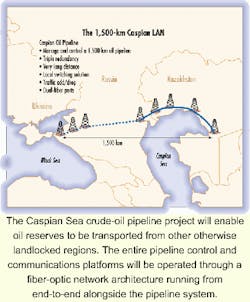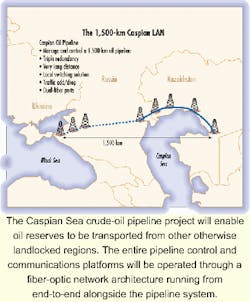Fiber-optic telecom provides control to oil flowing through Caspian pipeline
By ROBERT PEASE
According to the U.S. State Department, the Caspian Sea oil reserves, nearly 180 billion barrels, are critical to the world's oil supply for the next half-century. Efficiently transporting that oil from land-locked regions to a seaport for world distribution is expensive using trucks or trains. For that reason, the governments of the Russian Federation, Republic of Kazakhstan, the Sultan of Oman, and a group of oil companies formed the Caspian Pipeline Consortium (CPC).
The consortium will construct a single, shared pipeline transport system to export crude oil from the Tengiz oil field to a deep-water terminal on the Black Sea. In May 1999, Siemens Information and Communications Networks Group (Boca Raton, FL) was awarded a contract by the CPC to set up a turnkey fiber-optic telecommunications infrastructure worth approximately $55 million.
Siemens is currently installing high-density, polyethylene conduit directly into the ground. Once the conduit is in place and regional temperatures become warmer, the fiber will be blown in. The fiber-optic network will control the pipeline as one of its primary functions, performing command and control over the pipeline process as well as providing office communications between the multiple locations along the 1,500-km pipeline. The pipeline runs between Komsomolskaya to a new marine terminal at Novorossiysk. Twelve of the world's leading energy companies are involved in the project.
"The fiber is in place, but has not yet been deployed," says Kerim Koseoglu, communications engineer at Fluor Daniel Corp., the general contractor for the entire Caspian Sea project. Koseoglu serves as project manager. "The region we're talking about is split between two countries, Russia and Kazakhstan. In Kazakhstan, it floods out around the Caspian Sea during the winter months and everything is a half-meter or more underwater."
Trying to work in austere conditions is only part of the problem. Russian laws and regulations normally put into effect for other media are also hampering operations. For example, under Russian law, the communications line has to be on the left-hand side of the pipeline in terms of the flow direction. The fiber must also be placed exactly 9 m from the pipeline itself."When these specifications were written by the Russian government or Russian design institutes, they were designed for coaxial cable," says Koseoglu. "Even though our fiber has absolutely no metal in it, we still had to comply with the distance requirements laid out for coaxial cable. So we have some funny regulations to comply with."
The singlemode fiber-optic cable contains a bundle of 36 fiber strands. Armored fiber cable could not be used as added protection because of potential electrolysis problems that could occur by having metallic products too close to the pipeline. Ideally, says Koseoglu, two fiber cables would have been deployed, one on either side of the pipeline. Due to budget constraints and Russian regulations, the network had to be designed with a single cable at an overall length of 1,502 km.
"There will be a pump station every 200 km or so when the system is completed," says Koseoglu. "But for the initial phase of construction, we'll only have five pump stations from end to end. That will be enough to pressurize the line and move oil at a decent rate. At locations we've designated for future pump stations, there will be communications equipment placed into customized 8x20 isocontainers. These containers are heavily built to house necessary equipment and backup battery sources."
Once completed, there will be 17 pump stations along the pipeline. In between the pump stations, 87 mainline block-valve sites will be installed, approximately every 30 km, as a means to interrupt the oil flow in the event of a rupture or other emergency. These valves will also be housed in containers.
"Basically, these are big shutoff valves to prevent oil from being dumped all over the countryside if a rupture occurs," says Koseoglu. "These block valves are also operated through the fiber-optic network. Think of it as a two-tier, fiber-optic system. Even though we're on the same fiber cable, it's split into two tiers. The primary tier obviously goes from one end to the other through the 17 pump stations. The second sub-tier in between the pump stations controls the block valves that plug into either side of each pump station."
Structurally, reliability and redundancy are critical, but having only one fiber-optic cable presents major challenges. A supervisor control and data-acquisition (SCADA) system is used to monitor and control the pipeline. SCADA is an industrial monitoring and control system that includes a central master station and a number of remote data-gathering stations. Nbase-Xyplex (Chatsworth, CA) was chosen to provide the SCADA system as part of a contract involving the control, management, and security of the Caspian pipeline system. Using the SCADA system, one person, sitting at a remote location, can see the whole pipeline process and perform functional changes like stopping and starting. In fact, one person can control the entire operation, although the plan is to use two-one to handle the marine terminal's ship-loading operations and a second to monitor the entire pipeline.
"What makes this pipeline uni que from others through out the world is in using an office LAN [local-area network] technology, coupled with fiber- optic technology, to extend the distance to 1,500 km and still get tremendous speeds of 100 Mbits/sec at a very reasonable price," says Koseoglu. "What's critical in the design of this telecommunications system is that, under normal circumstances, if you lose the link in your communications system, it's more of an inconvenience. In this case, it's a real big deal. If the pipeline operations people lose sight of the pipeline because of a communications failure, they'll have to shut it down. One day's loss of operations equates to millions of dollars in lost revenue."
To avoid such a loss, the primary control is on two end-to-end fibers known as "SCADA one." A second set of electronics at each location and another set of fibers compose "SCADA two," which provides complete electronic and fiber redundancy. Since switched Ethernet is not intrinsically self-healing, says Koseoglu, if a cable break occurred, it could be a serious problem. Therefore, a third tier of redundancy has been added, using Synchronous Digital Hierarchy (SDH) multiplexers at each pump-station location.
"SCADA tier two would automatically, through a router, be routed into the SDH multiplexers since they can self-heal and provide two self-healed loops," says Koseoglu. "Now you might be wondering how we would connect one side of the loop to the other side of the loop, since the control is only at one end. At that point, we use a satellite link to connect the two halves of the pipeline system if we have a complete fiber break."
Fiber was chosen as the medium for the pipeline communications and control networks after several studies on the cost, technology, and reliability benefits of three alternatives: pure satellite, microwave, and fiber-optic technologies. The satellite system didn't provide enough bandwidth for the required daily-monitoring activities on the pipeline. Nearly 50,000 data points have to be scanned four times per second up and down the pipeline, requiring more bandwidth and speed than satellite technology could provide. Although economically viable, technologically it was not, says Koseoglu.
Microwave, though less expensive, was not secure enough and ruled out as too risky. Fiber, although more expensive, ultimately offered higher reliability, better throughput, and the option of selling dark fiber to offset deployment costs.
"Dark fiber has already been purchased by some main carriers in Russia," says Koseoglu. "This network will be used as an alternate leg of an ongoing national fiber-optic communication system. Network builders in the area that need some route diversity are taking a serious look at this as an alternate route within their own networks."
The current plan calls for the pipeline to be up and running by April or May of 2001 in order to test the control systems. By June 2001, the pipeline is expected to be transporting crude oil to ships in the Black Sea.

